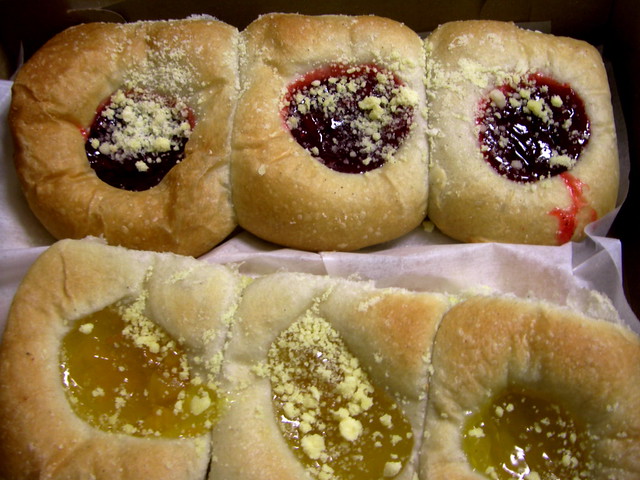Trying another recipe today
Last Christmas, one of my Facebook friends from Nebraska posted that someone had brought her a plate of kolaches, and she had already eaten one with blueberry filling, which was so good that she wanted to post about it. I thought I knew that kolaches were round, baked yeast rolls with a fruit filling in the center, but I searched for some recipes to confirm what I thought, and sure enough, I was right.
 |
| Tradiční české koláčky: Kolackys as made in the Czech Republic. Image from Wikimedia. |
About a month ago, I tried a kolache recipe that came from the website of a butter company. It called for 2-1/4 cups of butter in total, so I cut that back quite a bit, but otherwise, I followed the recipe fairly closely. Dennis became a huge fan of kolaches, as soon as he tried one.
Today I'm making kolaches for the second time, and I'm using a recipe for a folded kolache. It has a spicy dough that's made with a more reasonable ratio of shortening (oil) to flour. I have the dough resting in the refrigerator right now, and late tonight or early tomorrow morning, I will assemble and bake the kolaches.
This recipe is from the Smithsonian Folklife Cookbook by Katherine S. Kirlin and Thomas M. Kirlin, published in 1991 by the Smithsonian Institution Press in Washington and London. I got my copy at a local thrift shop. The recipe is credited to Genevieve Trinka of Lidgerwood, North Dakota.
KOLACHE DOUGH
Combine in a small bowl and set aside to soften:
3 tablespoons dry yeast
1/2 cup lukewarm water
1 teaspoon sugar.
Combine in a large mixing bowl:
2 cups warm milk (scalded and slightly cooled if raw)
3/4 cup sugar (I used half Splenda)
2 teaspoons salt (I cut this back to 1 teaspoon)
1/2 cup oil
1/2 teaspoon mace
1/2 teaspoon nutmeg (I had no mace so I used 1 teaspoon nutmeg)
1 tablespoon grated lemon peel
2 tablespoons lemon juice
3 eggs, well-beaten
Add:
2 cups flour
The yeast mixture that you set aside, above
Beat well, and add a little at a time:
5 cups flour (I used white whole wheat flour.)
This makes a very soft dough. Grease a large bowl, scoop the dough into it, cover, and place in the refrigerator overnight. I've had to stir it down twice now because it had risen over the top of the bowl, but surely the yeast process will slow down now that the dough is chilled completely.
FILLING
Here's what I'll be doing later.
The next day (or after the dough has chilled 8 or more hours,) get your filling and glaze ready. I'm going to use canned blueberry pie filling because I have some on hand, but many recipe websites have directions for making homemade fruit fillings. (For example, here are recipes for nine different kolache fillings.)
According to the Smithsonian cookbook and according to what I've read around the internet, prune, apricot, and poppy seed fillings are traditional. My mother would probably have called these fruit pockets and filled them with spicy applesauce. She loved applesauce as an old-timey fruit filling.
 |
| A folded kolatsche from Austria. Image from Wikimedia. My kolaches will be folded something like this, but I don't think the filling will be completely covered. |
GLAZE
Here is the recipe for egg glaze that the recipe book gives. I have not decided if I'll use this glaze, or just drizzle a little powdered-sugar glaze on them after they've baked. Or maybe I'll brush the hot kolaches with a little melted butter and sprinkle with powdered sugar.
1 egg beaten with 1 tablespoon water
1 cup sugar
1/3 cup flour
2 tablespoons butter, softened.
To assemble the kolaches, place some of the dough on a well-floured surface and pat it out to about 1/2 inch thick. Then cut it into 2 inch squares. Take a square, flatten it a little more, and place 1 teaspoon fruit filling in the center of it. Join diagonal corners of the square and squeeze the dough together a little to fasten at the center of the kolache. (Repeat for the other two corners.)
Brush tops of the kolaches with the egg glaze. Place on a well-greased cookie sheet. Let them rise. Bake at 350° until lightly-browned.
These are kolache recipes I'm going to try in the future:
- http://www.angelfire.com/tx5/texasczech/kolaches/Kolache%20recipe.htm
- http://czechmatediary.com/2007/05/18/kolache-recipe/
- http://www.toledoblade.com/Food/2012/02/05/Dinner-Tonight-Kolaches.html
 |
| Kolaches from a Texas bakery. Flikr photo. |


















